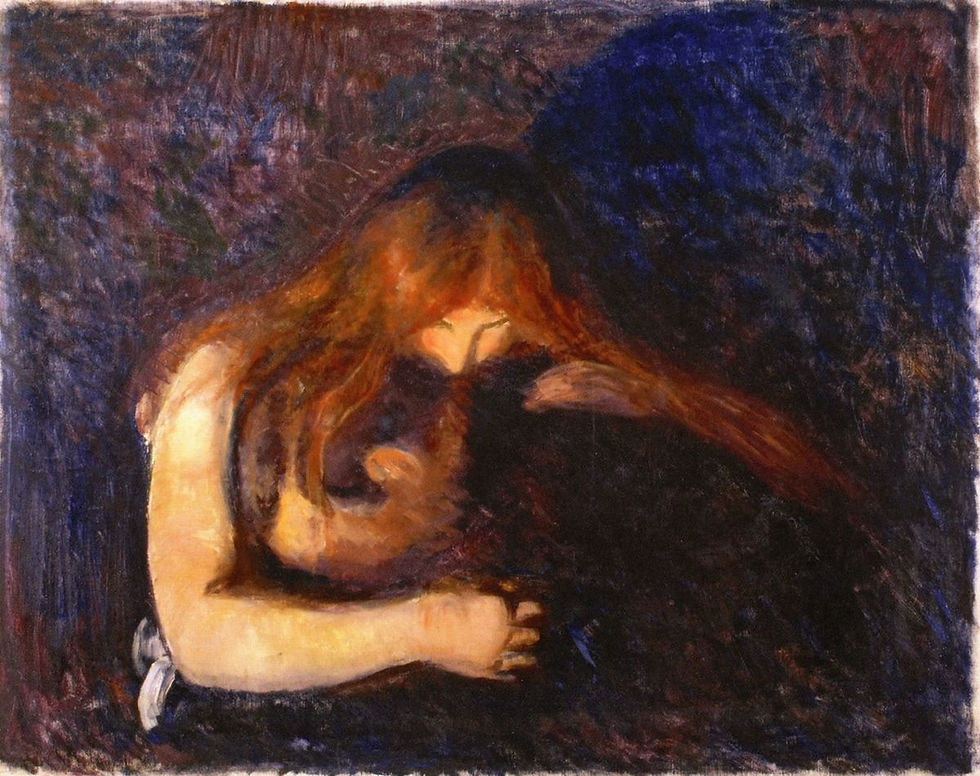Vampires: Myth or Medicine? By Claire Wong
- clairewong28398
- Oct 29, 2021
- 4 min read
Updated: Nov 15, 2021

Introduction
Midnight in Transylvania.
All is quiet. Neither child nor creature dares to stir the stillness, the silence, the serenity of the night. The once wild wind simmers down, reducing to only a whistling breeze. The beautiful birds, though alive with youth in the day, slumber so sweetly in the night. The sun, the eye of heaven, the heart of the day, finds respite under a rugged mountain. Though you revel in this tranquillity, a foreboding sense of danger brews in the air. Perhaps it’s the grandfather clock ticking in the hallway and its ghastly pendulum swaying dangerously from left to right. Perhaps it’s that unused harp in the corner with little hills of dust collecting on the broken strings. Perhaps it’s the dark shadows dancing so satanically on all four walls in your bedroom. Just as you’re about to sleep, an amorphous silhouette of a dark figure appears in your window. The window doors open. The curtains part to make way for this mysterious figure: a senile man with bloodshot eyes and enormous fangs. It’s Dracula…
Bram Stoker’s Dracula

Okay, so you’ve heard of Dracula… A nocturnal, blood-sucking creature brought to life by Irish author, Bram Stoker. Throughout the Gothic horror novel, Stoker reveals that the eponymous villain can transform humans into vampires by biting them, infecting his victims with vampiric disease. This is where it gets a little bit interesting… How did Dracula become a vampire if he wasn’t bitten by one in the first place? Don’t fear, I am here! No need to scramble onto the Internet and scour for information… I’ve done that for you!
The Long Awaiting Answer…
Surprise, surprise! Vampires are actually humans. They’re classified as non-human because of a disease that alters their appearance. There are many diseases that cause humans to appear as vampires but in this article, I would like to talk about a lesser-known one: porphyria.
What is Porphyria and what does it affect?
Porphyria is a blood condition that negatively affects the production of heme, an integral element of haemoglobin in our blood. So why is haemoglobin important? Well, haemoglobin enables red blood cells to carry oxygen from the lungs to organs, tissues, and pretty much anything in our body that requires oxygen. With that being said, if the production of heme in haemoglobin is disrupted, nasty chemicals called porphyrins invade our body. The term porphyrins refers to disorders that result from the growth of natural chemicals.
There are two types of porphyria: acute and cutaneous.
Acute porphyria mainly affects our nervous system. They can often appear suddenly and cause severe issues. Signs and symptoms of acute porphyria often last from days to weeks. One common form of acute porphyria is acute intermittent porphyria, a metabolic disorder.
Cutaneous porphyria mainly affects our skin, but not our nervous system. Usually, people with this disease are known to be sensitive to sunlight (like vampires!). One common form of cutaneous porphyria is porphyria cutanea tarda, or PCT for short. PCT is a disorder that causes blistering skin problems.
Signs and Symptoms of Acute and Cutaneous Porphyria
Acute Porphyria and Cutaneous Porphyria
Severe abdominal pain
Chest pain
Leg pain
Back pain
Constipation or diarrhoea
Vomiting
Muscle problems (tingling, pain, weakness, paralysis, numbness)
Red or brown urine
Urination problems
Breathing problems
Seizures
Heart palpitations (irregular or rapid heartbeats)
Anxiety, hallucinations, paranoia etc.
Sensitivity to sunlight or artificial light, usually with burning pain
Sudden erythema (skin redness) and edema (swelling)
Blisters on hands, arms or face
Itching
Excessive hair growth in certain, affected areas
Fragile thin skin
Changes in skin colour (pigment)
Red or brown urine
Genetic Forms
Believe it or not, most forms of porphyria are inherited. You might inherit this disease if you have:
A defective gene from one of your parents
Two defective genes from both of your parents
Okay, so that might be the bad news. However, inheriting porphyria doesn’t necessarily mean you will exhibit its signs and symptoms. This is called latent porphyria and is often the case for most carriers of the defective gene(s).
Risk Factors

Environmental factors may trigger porphyria. All risk factors affect the production of heme and encourage the build-up of porphyrins. They are as follows:
Excessive exposure to sunlight
Hormone drugs and other medications
Recreational drugs
Dieting or fasting
Smoking
Physical or emotional stress
Alcohol
Menstrual hormones
Diagnosis
If you exhibit any of the signs and symptoms shown in the table above, you might have acute or cutaneous porphyria. However, to make a definitive diagnosis of porphyria, medical professionals conduct lab tests. These tests include blood, urine or stool tests. Genetic testing may also be used if the doctor suspects that the disease is inherited.
Treatment
Ah yes, the treatment (AKA the best part)! Treatments vary depending on the severity of symptoms and what type of porphyria you have. They are as follows:
Acute Porphyria and Cutaneous Porphyria
Injections of hemin, a medication in the form of heme
Consuming intravenous sugar
Periodically drawing blood (phlebotomy)
Taking drugs such as Plaquenil (hydroxychloroquine) or Aralen (chloroquine)
A vitamin D dietary supplement
Conclusion
So, there you have it! Vampires are actually humans that may have porphyria, a blood condition affecting the production of heme. They’re not actually scary villains in Gothic horror novels such as Bram Stoker’s Dracula… or are they?
References
Comments